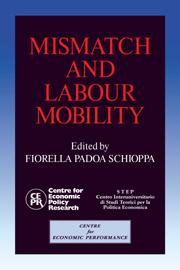Book contents
- Frontmatter
- Contents
- List of figures
- List of tables
- Preface
- Acknowledgements
- List of conference participants
- 1 A cross-country comparison of sectoral mismatch in the 1980s
- 2 Mismatch: a framework for thought
- Discussion
- 3 Match and mismatch on the German labour market
- Discussion
- 4 Mismatch in Japan
- Discussion
- 5 Mismatch and internal migration in Spain, 1962–86
- Discussion
- 6 Regional inequalities, migration and mismatch in Italy, 1960–86
- Discussion
- 7 Skill shortages and structural unemployment in Britain: a (mis)matching approach
- Discussion
- 8 Labour market tightness and the mismatch between demand and supply of less-educated young men in the United States in the 1980s
- Discussion
- 9 Skill mismatch, training systems and equilibrium unemployment: a comparative institutional analysis
- Discussion
- 10 Unemployment, vacancies and labour market programmes: Swedish evidence
- Discussion
- 11 Mismatch and labour mobility: some final remarks
- Index
3 - Match and mismatch on the German labour market
Published online by Cambridge University Press: 05 October 2010
- Frontmatter
- Contents
- List of figures
- List of tables
- Preface
- Acknowledgements
- List of conference participants
- 1 A cross-country comparison of sectoral mismatch in the 1980s
- 2 Mismatch: a framework for thought
- Discussion
- 3 Match and mismatch on the German labour market
- Discussion
- 4 Mismatch in Japan
- Discussion
- 5 Mismatch and internal migration in Spain, 1962–86
- Discussion
- 6 Regional inequalities, migration and mismatch in Italy, 1960–86
- Discussion
- 7 Skill shortages and structural unemployment in Britain: a (mis)matching approach
- Discussion
- 8 Labour market tightness and the mismatch between demand and supply of less-educated young men in the United States in the 1980s
- Discussion
- 9 Skill mismatch, training systems and equilibrium unemployment: a comparative institutional analysis
- Discussion
- 10 Unemployment, vacancies and labour market programmes: Swedish evidence
- Discussion
- 11 Mismatch and labour mobility: some final remarks
- Index
Summary
Introduction
In the past fifteen years unemployment in the Federal Republic of Germany (FRG), as well as in other countries, has experienced a tremendous increase, in many cases to a postwar high. At present it seems to be stuck at the levels reached in the mid-1980s. The focus of explanation for the causes of this rise of unemployment, and its persistence, has shifted towards structural factors. More specifically, it is claimed that among other determinants of structural unemployment, growing labour market imperfections and maladjustments such as a regional or qualitative mismatch between labour demand and supply and/or a reduced search intensity, partly supported by generous unemployment benefits, are important factors which can be blamed.
This study aims to take stock of the empirical evidence for and against these arguments. The prerequisite for an informed discussion of these issues is a theoretical framework which offers a clear-cut and empirically tractable definition of structural unemployment. The study uses two theoretical tools, namely the unemployment/vacancy relationship (u/v curve), often christened the ‘Beveridge curve’, and a macroeconometric disequilibrium model, in order to provide a basis for the empirical investigation. The study is organised as follows. In section 2 the Beveridge curve and in section 3 the rationing model are employed to check whether there are structural imbalances on the German labour market, and whether they have increased; as it turns out, there is some reason to accept both premises. Hence, in section 4 the study goes on to try to identify the causes of these growing maladjustments. In section 5 the importance of some possible causes is tested, using the two tools discussed. Section 6 presents some concluding remarks.
- Type
- Chapter
- Information
- Mismatch and Labour Mobility , pp. 105 - 135Publisher: Cambridge University PressPrint publication year: 1991
- 1
- Cited by



